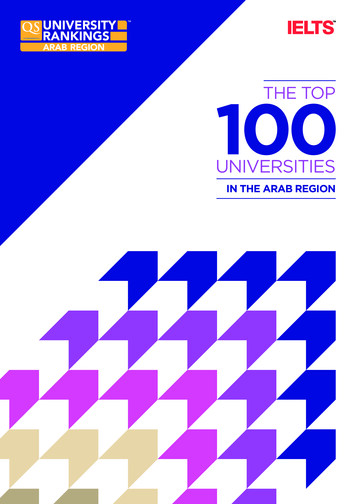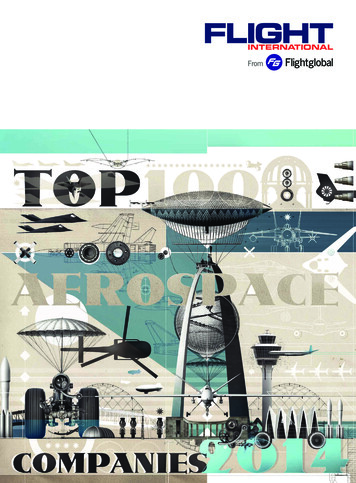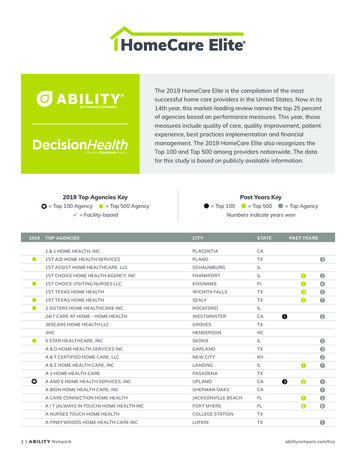
Transcription
ARAB REGIONTHE TOPUNIVERSITIESIN THE ARAB REGION
IELTS, theonly test youneed for study,work and lifeMore people go moreplaces with IELTS Book a test up to once a week in over140 countries Receive your results in less than 2 weeks 10 hours of free ‘Road to IELTS’ preparationmaterials with the British Council Submit your results to thousands of institutionsin Australia, Canada, the UK and the USBook now at www.britishcouncil.org/takeieltsIELTS is jointly owned by the British Council, IDP: IELTS Australia and Cambridge English Language Assessment.choosebookprepareresults
Welcometo the 2015 QS University Rankings:Arab Region ReportRankings are gloriously simple and thatmakes them appealing and essential fordeveloping a broad view.Despite being able to show only what is on the surface ofthis complex entity ‘university’, rankings enjoy a high levelof acceptance among stakeholders and the wider publicand they do have impact. But its simplicity and consumertype information also makes them controversial since theyrepresent a fixed moment in time and a limited lens oninstitutional performance.One of the common criticisms of university rankings is thattheir methodologies do not always manage to accuratelycapture the different features and characteristics ofdifferent geographical and cultural settings. So, whilsta global ranking seeks to identify truly world classuniversities, a regional ranking needs to adapt to therealities of the region. Exactly that narrower geographicfocus enables us to dig deeper and develop richer datasetsnot only placing universities of the region into sharpercontrast with each other but also stressing a particulardefinition of that region.QS has been publishing a global university ranking since2004, and regional rankings since 2009, acknowledging thefact that the international higher education landscape ischanging and that universities from the developing worldwill without doubt play a crucial role in tomorrow’s highereducation.Nunzio Quacquarelli, CEO of QS says: “Particularly inthe Arab region, education has been witnessing rigorousmoves toward internationalization, such moves have beensupported by educational institutions in public and privatesectors in the area, aspired to equip younger generationswith contemporary and robust education aligned tointernational standards/practices.” A trend that wasalready reflected as part of an international project by theInstitute of International Education (IIE) and the Lebaneseby BaerbelEckelmannResearchManagerAssociation for Educational Studies in 2012 that intendedto lead to a better understanding of the strengths andweaknesses of higher education across the Middle East andNorth Africa.With this in mind, the QS Intelligence Unit executed itspilot edition of the QS University Ranking: Arab Regionin November 2014 enabling us to dig deeper into what ishappening in the developing economies of the Arab world.Rather than solely as source of information pertainingto quality, this full version of the ranking should also beseen as a tool that can help improve transparency andaccountability in the regional and global market of highereducation.Based on an extensive consultation undertaken withuniversity leaders in the region aiming to identify a strongyet practical methodology, the main rankings table iscompiled based on nine distinct indicators – AcademicReputation, Employer Reputation, Faculty Student Ratio,International Faculty, International Students, Staff withPhD, Web Impact, Papers per Faculty and Citationsper Paper, emphasising the importance of researchcollaborations, the relevance of an international facultyand international student body and the bridge betweenuniversities and employers, which remain a unique keyfeature of our ranking systems.However, opportunities and challenges lie in the rapiddevelopment of and diversity of higher education in theArab Region. We therefore strive to widen the level ofengagement we have established with universities andwe are confident that the rankings project will catalysecooperativeness among universities regionally andinternationally.Particularly in the Arab region,education has been witnessingrigorous moves towardinternationalization.Nunzio QuacquarelliCEO of QSQS University Rankings: Arab Region 20153
QS University Rankings: Arab Region 2015COMPARINGAMBITIONSFAST-EVOLVING AND DIVERSEUNIVERSITIES IN THE ARAB WORLDThe first full university ranking for the Arab world includesinstitutions from 15 of the 21 countries that are eligible forinclusion. But the strength of the leading universities in SaudiArabia stands out as they take three of the top four places.QS was one of three ranking organisations to publish aprovisional ranking for the region in the past year. Today’sexercise is the both the first confirmed Arab ranking andthe most comprehensive, featuring 100 universities.As in the provisional ranking, King Fahd University ofPetroleum and Minerals, in Dhahran, Saudi Arabia,emerges as the region’s top institution, finishing in the top20 on six of the nine indicators. The American Universityof Beirut (AUB) is less than a point behind and is thefavourite choice of employers.There have been no changes of methodology since lastyear’s provisional ranking, which was the product oflengthy consultation in the region. QS had hoped to addcitations in Arabic, but was unable to find a reliable source.The search is continuing for future editions of the ranking.The methodology has been discussed this year at theQS Maple conference, in Doha, and the MENA-AIRconference in Byblos, Lebanon. Like the other regionalrankings produced by QS, it includes measures that donot feature in the QS World University Rankings. Datafrom the Webometrics ranking are used, for example,to show universities impact online. While half of eachuniversity’s score comes from the two reputationalsurveys, 20 per cent is from the poll of employers (twicethe percentage in the World Rankings) and only 30 percent from academics.More than 3,720 academics and 2,489 employers havecontributed views for the new ranking, which also takesinto account staffing levels, the proportion of academicswith a PhD, the number of research papers per facultymember and the number of citations per paper, as wellas the proportions of international faculty and students,and web impact.4QS University Rankings: Arab Region 2015by John O’LearyAlmost 260 institutions were evaluated during theexercise and 194 had enough data to be ranked, as wellas being sufficiently broad-based to be included. Ofthese, 100 appear in the published ranking, with thosebelow 50th place grouped together in bands of tenbecause the scores become too close to separate eachuniversity reliably.Universities in the 21 countries in membership of theArab League were eligible for inclusion. But no data couldbe collected on universities in Syria, and the universitiesof Mosul and Tikrit, in Iraq, were reported to be closed atthe time that the ranking was compiled. However, otherinstitutions in Iraq are included, with the University ofBaghdad rising eight places since last year’s provisionalranking and making the most progress among those inthe top 20.3,720 academicsand 2,489employers havecontributed viewsfor the new ranking.
KING FAHD UNIVERSITY OF PETROLEUM & MINERALSNine of the top 20 are classified as‘extremely large’, some with as manyas 200,000 students.Other universities to rise sharply in the top 20 are QatarUniversity, which is now on the verge of the top ten, SultanQaboos University, in Oman, and King Khalid University, inSaudi Arabia. All three have moved up five places.Saudi Arabia has the largest number of universities in theranking, at 19, while Egypt has 15 and the United ArabEmirates (UAE) 13. Egypt, Jordan and the UAE each havetwo universities in the top ten, while Saudi Arabia hasthree and Lebanon one.The results correlate well with those in the provisionalranking: the average change in position in the top 50 is0.66. The most significant move in the top 50 is by NotreDame University - Louaize (NDU), in Lebanon, whichhas risen 30 places after improved polling among bothacademics and employers.The provisional ranking caused considerable interest in theregion, with Arab World reporting that students in SaudiArabia were “ecstatic” at the performance of their leadinguniversities. Mansour Elhabonym, an undergraduateat KSU, was quoted as saying: “It is really great thatour universities are doing well as against other gooduniversities in the Arab countries, which makes us feelproud of the great achievement in the education sector.”Saudi Arabia has invested heavily in higher education inrecent years. King Saud University, in Riyadh, topped thepolling among academics and is also considered to havethe strongest web profile. It finishes in third place in thenew ranking, with King Abdul Aziz University, in Jeddah,in fourth position.L’Université de Sousse, one of Tunisia’s fiverepresentatives in the new publication, is the onlyinstitution to enter the top 50 since the provisionalranking appeared.The ranking reflects the diversity among universitiesin the Arab region. Nine of the top 20 are classified as‘extremely large’, some with as many as 200,000 students.Most are fully comprehensive, public institutions, andrelatively few have a strong research focus.Nine of the universities in the ranking are classified as‘new’, at less than ten years old, while another 27 aredescribed as ‘young’. The American University of Sharjah,in the United Arab Emirates, is the highest-placed ofthese, in seventh position and established only in 1997.QS University Rankings: Arab Region 20155
Academic EmployerReputation Reputation6SCORESCOREOverall 60.542.7KING KHALID UNIVERSITYXLFCMD2A82.1UNIVERSITY OF BAGHDADXLFCMD4A86.8AMERICAN UNIVERSITY IN DUBAISFOMD2BUNIVERSITÉ SAINT-JOSEPH DEBEYROUTHLFCMD5B15UNIVERSITY OF SHARJAHLCOMD22223ZAYED UNIVERSITYMCOMD2318KING FAISAL UNIVERSITYXLFOHI2420KHALIFA UNIVERSITYSSPMD2524UNIVERSITY OF BALAMANDMCOMD2628AL-IMAM MOHAMED IBN SAUD ISLAMICUNIVERSITYXLCO2725ABU DHABI UNIVERSITYSFO2830ARABIAN GULF UNIVERSITYS2929YARMOUK UNIVERSITYXL3031KUWAIT UNIVERSITY3133MANSOURA UNIVERSITY3235BEIRUT ARAB UNIVERSITYVH4FCHI5FCVH4XLFCHI3MCOHI4UNITED ARAB EMIRATES UNIVERSITYMFCHI3AMERICAN UNIVERSITY OF SHARJAHMFCMD28UNIVERSITY OF JORDANXLFCMD49CAIRO UNIVERSITYXLCOVH51010JORDAN UNIVERSITY OF SCIENCE ANDTECHNOLOGYLCOHI1116QATAR UNIVERSITYMFC1211ALEXANDRIA UNIVERSITYXLFC1313AIN SHAMS UNIVERSITYXL1419UMM AL-QURA UNIVERSITY (UQU)XL1514LEBANESE AMERICAN UNIVERSITY1621SULTAN QABOOS CUSSCORE54.0SCORE100.0SCORE97.1AFOM2KING FAHD UNIVERSITY OFPETROLEUM & MINERALS (KFUPM)AMERICAN UNIVERSITY OF BEIRUT(AUB)M3KING SAUD UNIVERSITY (KSU)XL45KING ABDUL AZIZ UNIVERSITY (KAU)54AMERICAN UNIVERSITY IN CAIRO667789Institution NameWebImpact54.2SCORE3Citations International InternationalFacultyStudentsper PaperSCORE2Paper perFacultySCORE1Staff withPhDSCORE2014 RANK1FacultyStudentSTATUS2015 RANKARAB REGIONCountry / TerritoryClassificationMFCMD4NOTRE DAME UNIVERSITY - EBANESE AL 0.044.63632HIGHER COLLEGES OF 44.23734AL AZHAR 058.739.238 37 UNIVERSITY OF BABYLON39402.61.045.4UNIVERSITÉ DE TUNIS EL MANARXLFCMD2A74.962.57.921.038.540 37 ASSIUT HRAIN 248UNIVERSITY OF 37.14343PRINCE SULTAN 17.236.94441PETRA 7.236.54539UNIVERSITY OF NIVERSITY OF 0PRINCESS SUMAYA UNIVERSITY .734.14844ZAGAZIG 14949HASHEMITE 950-UNIVERSITÉ DE SOUSSELFCMD2A51.045.87.99.033.91.725.331.5QS University Rankings: Arab Region 20151.15.94.5
0GERMAN UNIVERSITY OF TECHNOLOGYIN OMAN (GUTECH)SFOLO1C--95.179.351-60TANTA UNIVERSITYXLFCMD3A--18.061.212.563.051-60AL MUSTANSIRIYA UNIVERSITYXLFCLO4A--60.06.72.516.651-60HELWAN UNIVERSITYXLCOMD3A--21.071.38.353.151-60UNIVERSITY OF SULAIMANIMCOMD3A--95.96.73.034.251-60QASSIM UNIVERSITYXLFCMD2A--38.729.56.034.751-60ISLAMIC UNIVERSITY OF MEDINAHLFOLO4A--23.986.451-60AL AKHAWAYN UNIVERSITY IFRANESCOMD2A--69.06.633.99.651-60NAJRAN UNIVERSITYLFCLO1A--50.437.88.782.761-70DAR AL-HEKMA COLLEGE FOR WOMENSSPLO2B--100.061-70GULF UNIVERSITYSSPLO2C--100.061-70UNIVERSITY OF BASRAHSFCMD4A--61-70JAZAN UNIVERSITYXLFCLO1A--38.932.861-70UNIVERSITÉ MOHAMMED V - AGDALXLFOHI2A--18.461-70UNIVERSITÉ DE TUNISLFOHI4A--61-70AN-NAJAH UNIVERSITYLFCLO3A--61-70BIRZEIT UNIVERSITYMCOMD3A-61-70AJMAN UNIVERSITY OF SCIENCE& TECHNOLOGYMCOMD3C61-70HOLY SPIRIT UNIVERSITY OF KASLIKMFCLO4C71-80SUEZ CANAL UNIVERSITYXLCOHI371-80TAIBAH UNIVERSITYXLFCMD71-80AL QUDS UNIVERSITY THE ARABUNIVERSITY IN JERUSALEMLFCLO71-80UNIVERSITY OF DAMMAMXLCO71-80PRINCE MOHAMMAD BIN FAHDUNIVERSITYS71-80UNIVERSITY OF KUFAL71-80UNIVERSITÉ DE MONASTIRLCOHI71-80UNIVERSITY OF DOHUKMCO71-80CANADIAN UNIVERSITY OF DUBAIS71-8081-90PARIS-SORBONNE UNIVERSITY IN ABUDHABIAMERICAN UNIVERSITY OF RAS ALKHAIMAH ( AURAK )81-90Overall SCORESCOREBRITISH UNIVERSITY IN EGYPT51-60Institution NameSCORESTATUS51-60WebImpactSCOREAGECitations International InternationalFacultyStudentsper PaperRES.Paper perFacultyFOCUSStaff withPhDSIZECountry / Territory2015 RANKARAB REGIONFacultyStudentSCOREAcademic EmployerReputation -49.044.3SCOLO1A--90.329.310.9APPLIED SCIENCE UNIVERSITYMCOMD3C--78.520.66.554.481-90BENHA UNIVERSITYXLFCMD3A--29.961.58.836.481-90HAIGAZIAN UNIVERSITYSCOLO--89.13.74.25.881-90HARIRI CANADIAN UNIVERSITYSCOMD2B--86.833.514.181-90PHILADELPHIA UNIVERSITY AT JORDANMCOMD3C--30.379.315.981-90UNIVERSITÉ ANTONINESCOLO4--100.07.881-90UNIVERSITY OF KERBALALFCLO2A--41.826.081-90AL-ANBAR UNIVERSITYMCOLO3A--78.66.71.781-90CALEDONIAN COLLEGE OFENGINEERINGSCOMD--78.218.24.791-100GERMAN JORDANIAN UNIVERSITYSCOMD--59.939.615.691-100MAJMAAH UNIVERSITYLFCLO1A--51.321.991-100MINIA UNIVERSITYXLCOMD3A--28.464.991-100OMAN MEDICAL COLLEGE OMCSCOLO--70.484.291-100SUDAN UNIVERSITY OF SCIENCE ANDTECHNOLOGYLCOMD3A--59.991-100UNIVERSITÉ DE GABÈSLCOMD--91-100OCTOBER 6 UNIVERSITYLCOLO2C--91-100UNIVERSITÉ HASSAN II CASABLANCALCOMD-91-100TAIF UNIVERSITYXLFCMD91-100UNIVERSITY OF ADENLCOLOBAHRAINEGYPTQATARSAUDI .5LEBANONUNITED ARAB 1.52.614.719.8PALESTINEYEMENQS University Rankings: Arab Region 20157
@ReimagineHEduCall forSubmissionsnow open atreimagine-education.comReimagine EducationAwards 2015The global awards for innovative highereducation pedagogies enhancing learningand employabilityConference & Awards Ceremony:Philadelphia 7-9 DecemberAn international panel of distinguished judges will selectthe best projects for the following Awards:e-Learning, Hybrid Learning, Presence Learning,For Profit and Non-For ProfitPrize fund up to 50,000Register your interest as a participant in the competitionor as a conference delegate at reimagine-education.comThe 2014 inaugural competition attracted 427 submissionsfrom 54 countries.For sponsorship opportunities contactJason Newman Jason@qs.com
1 1 king fahd university of petroleum & minerals (kfupm) m fo vh 4 a 100.0 94.3 96.4 85.3 82.8 77.9 100.0 54.2 97.1 100.0 2 2 american university of beirut











